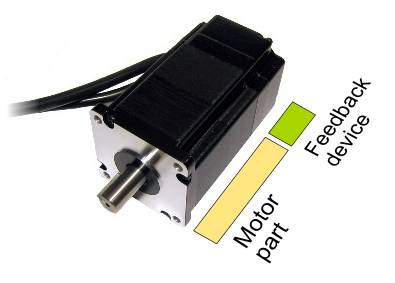Difference between revisions of "Motor types"
| [checked revision] | [checked revision] |
(→Comparison) |
|||
| (3 intermediate revisions by 2 users not shown) | |||
| Line 26: | Line 26: | ||
Brush DC (direct current) motors typically have permanent magnet stator and rotor with mechanical commutator with brushes. | Brush DC (direct current) motors typically have permanent magnet stator and rotor with mechanical commutator with brushes. | ||
===Stepping motor=== | ===Stepping motor=== | ||
| − | + | [[Stepping motor|Stepping motors]] are high pole count permanent magnet brushless motors with 2 or 3 phase windings. High pole count enables position control without feedback devices but with several drawbacks such as risk of lost position and possible resonance issues. | |
==Comparison== | ==Comparison== | ||
| Line 36: | Line 36: | ||
| [[Closed loop]] || No || Yes || Yes || Yes | | [[Closed loop]] || No || Yes || Yes || Yes | ||
|- | |- | ||
| − | | Torque control || | + | | [[Control modes|Torque control]] || Yes with position feedback device || Yes || Yes || Yes |
|- | |- | ||
| − | | Velocity control || Yes || Yes || Yes || Yes | + | | [[Control modes|Velocity control]] || Yes || Yes || Yes || Yes |
|- | |- | ||
| − | | Position control || Yes || Yes || Yes || Yes | + | | [[Control modes|Position control]] || Yes || Yes || Yes || Yes |
|- | |- | ||
| Available speed range || Low, Medium || Medium || High || Highest | | Available speed range || Low, Medium || Medium || High || Highest | ||
| Line 48: | Line 48: | ||
| Dynamic performance || Low, medium || Medium||High||High | | Dynamic performance || Low, medium || Medium||High||High | ||
|- | |- | ||
| − | | Motion smoothness || Low to | + | | Motion smoothness || Low to medium||Medium||Medium||High |
|- | |- | ||
| Endurance || High || Medium || High || High | | Endurance || High || Medium || High || High | ||
Latest revision as of 11:08, 2 October 2015
Position, velocity and torque/force control applications mainly rely on two main categories of motors: servo motors and stepping motors.
- Servo motor
- Electromechanical actuator with feedback allowing precision closed loop motion control and monitoring. Servo motor also enables precise torque limitation to gain safety.
- Stepping motor
- A low cost alternative to servo motors and can be operated without feedback devices.
Contents
Construction[edit | edit source]
Servo motor consists two main parts:
- Motor part - typically electromagnetic device that produces torque or force when driven with current
- Feedback device - typically electronic device that outputs measurement information such as shaft angle or velocity
Stepping motors can be used without any feedback device.
Shapes[edit | edit source]
Motors and feedback devices come mainly in two shapes:
- Rotary
- Linear
Shape of motor doesn't change their electromechanical principle so both types of motors can be driven with same drives.
Motor technologies[edit | edit source]
List of electromagnetic motor part types.
AC[edit | edit source]
Typical AC (alternating current) servo motor is a 3 phase permanent magnet syncronous machine. This type of motors are driven by 3 wires each driving one phase coil. In ideal case 3 phase AC servo is driven by sinusoidal current waveforms that are synchronized to the permanent magnet rotor.
BLDC[edit | edit source]
BLDC (brushless DC) is very similar to AC motor with only expection that it is desgined to be driven by trapezoidal current waveforms instead of sinusoidal. BLDC motors can always be driven with same drives regardless of current waveform matching.
Brush DC[edit | edit source]
Brush DC (direct current) motors typically have permanent magnet stator and rotor with mechanical commutator with brushes.
Stepping motor[edit | edit source]
Stepping motors are high pole count permanent magnet brushless motors with 2 or 3 phase windings. High pole count enables position control without feedback devices but with several drawbacks such as risk of lost position and possible resonance issues.
Comparison[edit | edit source]
Comparison of motor technologies
| Stepping motor | DC servo | BLDC servo | AC servo | |
|---|---|---|---|---|
| Closed loop | No | Yes | Yes | Yes |
| Torque control | Yes with position feedback device | Yes | Yes | Yes |
| Velocity control | Yes | Yes | Yes | Yes |
| Position control | Yes | Yes | Yes | Yes |
| Available speed range | Low, Medium | Medium | High | Highest |
| Rated torque vs size | High | Low | Medium | Medium |
| Dynamic performance | Low, medium | Medium | High | High |
| Motion smoothness | Low to medium | Medium | Medium | High |
| Endurance | High | Medium | High | High |
| Energy efficiency | Low, medium | Medium | High | High |
| Safety concerns | No safe torque limit,
loss of position, hot surface |
Runaway if feedback lost |
